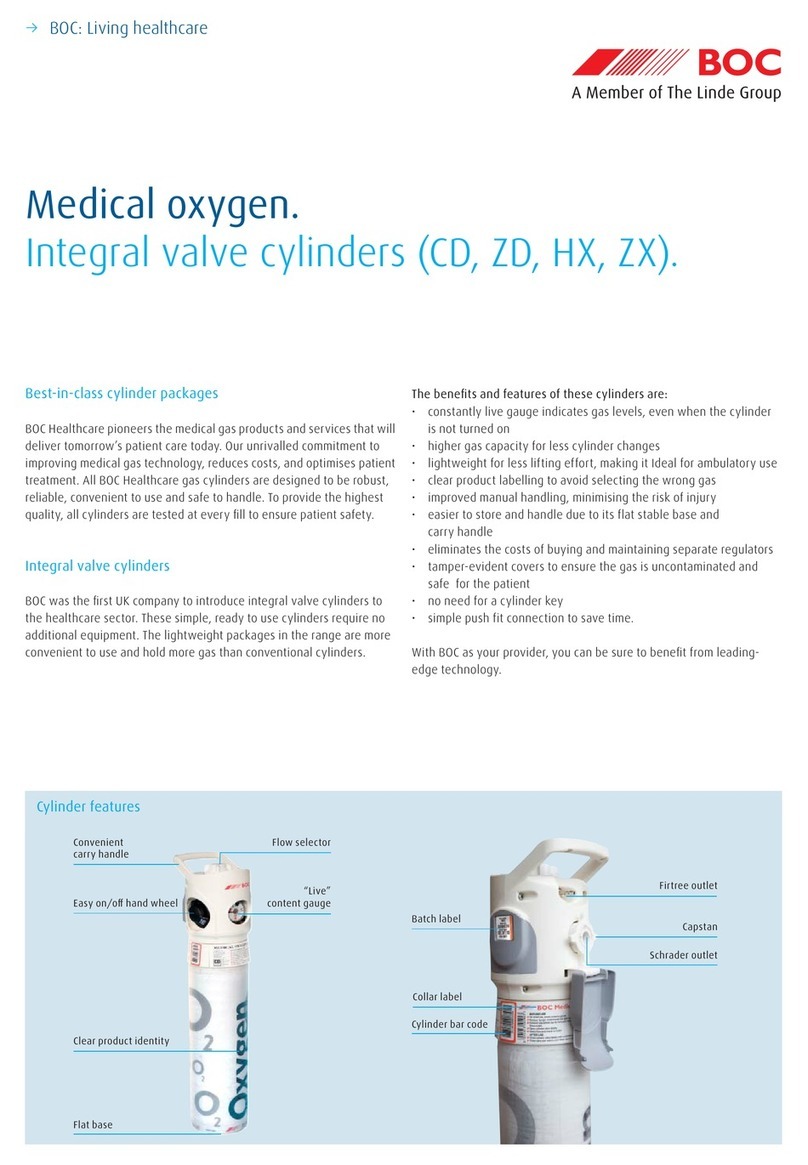03Cylinder instructions
5.5 Replace the outlet cover by
pulling up the hinged grey cover.
5.1 Remove the demand valve
from the patient. If the treatment
is fi nished safely dispose of the
fi lter and mouthpiece or mask.
4.1 Instruct the patient on how to
use the demand valve correctly
before commencing therapy.
The gas should be inhaled for
at least 2 minutes prior to
starting any procedure for
optimum pain relief.
3.5 Check the demand valve is
operating by pushing the “test
button”. Ensure you can hear the
gas fl owing.
3.1 Ensure the demand valve
is clean and ready for use. You
will need a single patient use
mouthpiece or face mask.
5.3 Vent any residual gas in the
hose by pressing test button on
the demand valve. Wait for the
gas to stop venting.
4.3 Ensure the clinical condition
of the patient remains satisfactory
throughout the therapy.
If the patient experiences
complications ask them to stop
inhaling the gas.
4.4 Check the contents gauge at
regular intervals (as described
in 2.3), to make sure there is
enough gas to continue the
therapy.
3.3 Insert the probe on the hose
connected to the demand valve
into the Schrader outlet. Push
fi rmly to ensure the probe clicks
securely into place.
3.4 Slowly turn on the
cylinder by rotating the hand
wheel anti-clockwise until it
comes to a stop. Do not use
excessive force.
5.6 Check the cylinder gauge, for
content level (refer to nominal
duration chart). Return the
cylinder to a designated ‘in use’
or empty storage area.
5.2 Turn off the cylinder by
rotating the hand wheel clockwise
until it comes to a stop. Do not
use excessive force.
4.2 Use scavenging equipment
whenever possible, to avoid a
build up of nitrous oxide in the
environment. If scavenging is
not possible, use in a well
ventilated area.
3.6 Check for leaks which maybe
indicated by a hissing sound.(1)
3.2 Fit a new microbial fi lter to the
demand valve. Fit a new fi lter/
mouthpiece for each patient to
prevent cross contamination.
5.4 Disconnect the probe from
the cylinder outlet. Holding the
probe twist the capstan and
withdraw it from the outlet.
5. After use
4. Monitoring during use
Note:
(1) If you suspect that you have a leak, turn off the cylinder and check
the equipment is properly connected. Turn on the cylinder and re-check
for leaks. If the leak continues, turn off and quarantine the cylinder and
contact BOC Healthcare.
02 Cylinder instructions
Instructions for use.
1. Initial safety checks
Before handling cylinders ensure your hands are clean. If you have
been using alcohol based gel or liquids to decontaminate your hands
make sure the alcohol has totally evaporated.
2.1 Ensure you have the correct
medical gas by checking the
cylinder label.
2.5 Open the valve outlet cover.
The hinged grey cover is pulled
down. Do not remove the grey
cover and refi t after use.
When selecting the cylinder for use, check that the cylinder is free from
oil and grease, particularly around the Schrader outlet. Check that the
cylinder is not damaged in any way, if it is contact BOC.
2.3 Make sure the contents gauge
is in the green zone. This indicates
that the cylinder is FULL.
2.2 Check the expiry date on the
batch label. Use cylinders with
the nearest expiry date.
2.4 Remove the tamper evident
handwheel cover by pulling the
tear ring. Discard the cover into
the recycle bin. If the cylinder
has been used before this cover
will not be present.
2. Preparing a new cylinder for use
3. Connecting a demand valve to the Schrader outlet
If the cylinder has been used before make sure you have suffi cient gas for treatment by inspecting the
contents gauge. If the needle is in the red zone there is limited capacity and you may need to change
the cylinder (see nominal duration chart overleaf).
In the event of an emergency,
or if you suspect your cylinder
is leaking, contact BOC
Healthcare on 0800 111 333.
2.6 Place the cylinder in a
safe location, preferably in an
appropriately designed cylinder
holder fi tted to the patient‘s bed.
Note:
Ideally the cylinder should not be placed on the bed next to the patient.
If there is no alternative; before placing on the patient‘s bed make
sure that:
• the equipment is connected
• the cylinder is turned on and not leaking (see 3.1 to 3.6)
• check there is a gas fl ow by pressing the test button.





















